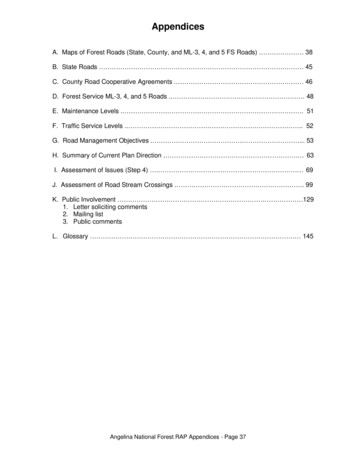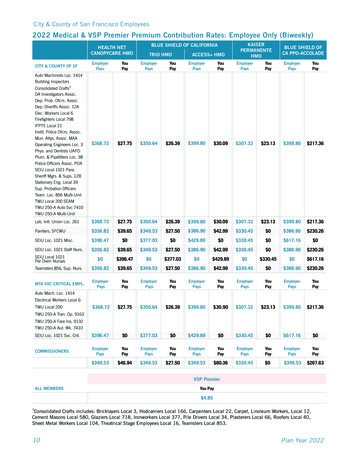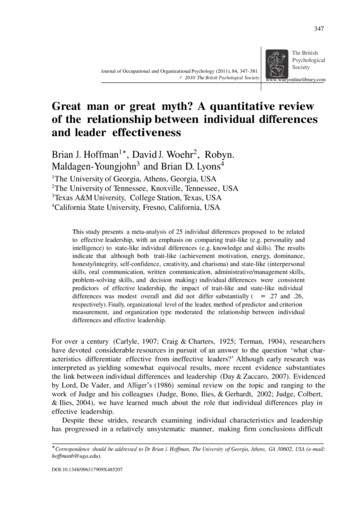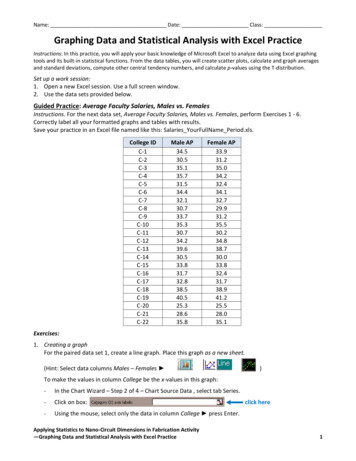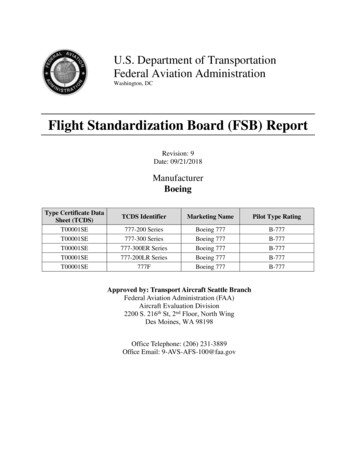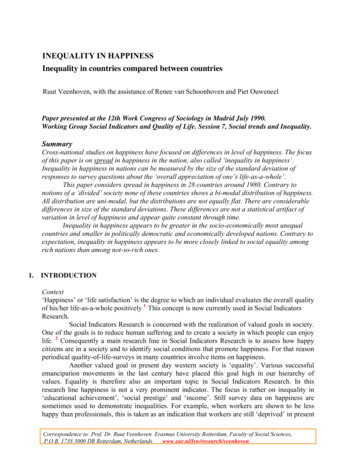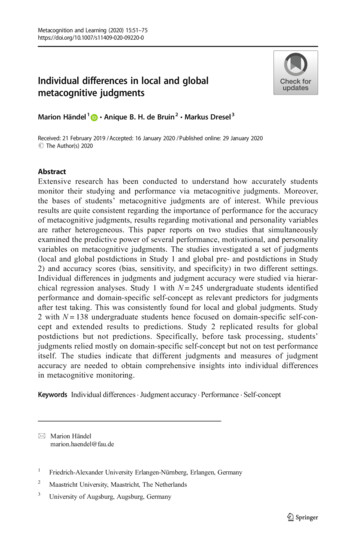
Transcription
Metacognition and Learning (2020) -0Individual differences in local and globalmetacognitive judgmentsMarion Händel 12& Anique B. H. de Bruin & Markus Dresel3Received: 21 February 2019 / Accepted: 16 January 2020 / Published online: 29 January 2020# The Author(s) 2020AbstractExtensive research has been conducted to understand how accurately studentsmonitor their studying and performance via metacognitive judgments. Moreover,the bases of students’ metacognitive judgments are of interest. While previousresults are quite consistent regarding the importance of performance for the accuracyof metacognitive judgments, results regarding motivational and personality variablesare rather heterogeneous. This paper reports on two studies that simultaneouslyexamined the predictive power of several performance, motivational, and personalityvariables on metacognitive judgments. The studies investigated a set of judgments(local and global postdictions in Study 1 and global pre- and postdictions in Study2) and accuracy scores (bias, sensitivity, and specificity) in two different settings.Individual differences in judgments and judgment accuracy were studied via hierarchical regression analyses. Study 1 with N 245 undergraduate students identifiedperformance and domain-specific self-concept as relevant predictors for judgmentsafter test taking. This was consistently found for local and global judgments. Study2 with N 138 undergraduate students hence focused on domain-specific self-concept and extended results to predictions. Study 2 replicated results for globalpostdictions but not predictions. Specifically, before task processing, students’judgments relied mostly on domain-specific self-concept but not on test performanceitself. The studies indicate that different judgments and measures of judgmentaccuracy are needed to obtain comprehensive insights into individual differencesin metacognitive monitoring.Keywords Individual differences . Judgment accuracy . Performance . Self-concept* Marion Händelmarion.haendel@fau.de1Friedrich-Alexander University Erlangen-Nürnberg, Erlangen, Germany2Maastricht University, Maastricht, The Netherlands3University of Augsburg, Augsburg, Germany
52M. Händel et al.In a perfect (self-regulated learning) world, learners consistently monitor their progress andadapt their learning activities according to the results of these monitoring judgments (Nelsonand Narens 1990). Based on their metacognitive monitoring judgments, students are supposedto initiate regulation processes. Therefore, monitoring activities should affect students’ futureeffort and learning behavior and should consequently lead to higher performance (Winne andHadwin 1998). However, this interplay of monitoring and regulation works smoothly only ifmonitoring judgments are accurate. Indeed, students are predominantly inaccurate judges oftheir individual performance and tend to overestimate their test performance (e.g., Händel andDresel 2018; Kruger and Dunning 1999). Hence, the question arises as to why studentsprovide biased judgments or, in other words, what the bases of students’ (inaccurate) judgments are. The current two studies used an individual differences approach to understand whysome students are able to accurately judge their performance and others are not. Based ontheoretical and empirical grounds, we simultaneously studied performance, motivation, andpersonality as possible predictors for metacognitive judgments.Theoretical backgroundMetacognitive judgments are inferential in nature (Perfect and Schwartz 2002). These inferences are based on cues people have access to when judging performance. The cue-utilizationapproach by Koriat (1997) provides a theoretical model suitable to understand different causesfor metacognitive judgments and their accuracy. According to this approach, the accuracy ofjudgments depends on the availability of specific cues. The cues students use to generate theirjudgments can be based on previously gathered information—information-based (or theorybased) cues. In this case, students might base their judgments on preconceived notions aboutcompetence, for example, due to their self-concept beliefs, prior success in the respectivedomain, or time and effort for studying. In addition, students might base their judgments ontheir concrete experiences during task processing, like experienced retrieval fluency or detection of potential difficulties with the tasks—experience-based cues (Koriat et al. 2008).Metacognitive judgmentsTo understand how these two types of cues affect judgment accuracy, one needs to distinguishbetween different types of judgments (for an overview, see Nelson and Narens 1990; Schraw2009). First, judgments of test performance can differ according to their grain size; that is, theycan be made on a local or global level. While global judgments are assessed at the test level,local judgments refer to each single task. In addition, judgments are distinguished according tothe point in time at which they occur: Predictions are made before test taking and postdictionsare made after test taking. Research on metacognitive judgments offers a wide variety ofaccuracy scores for local as well as global judgments. The scores can be distinguished intoabsolute accuracy (synonymous to calibration) and relative accuracy scores (synonymous todiscrimination; Bol and Hacker 2012). Absolute accuracy scores measure the overall precisionof judgments compared to performance, while relative accuracy scores measure the relationship of judgments and performance scores. Global judgments allow calculating their over- orunderconfidence (bias score). Assessing local judgments in a dichotomous rather than acontinuous way furthermore offers the opportunity to analyze their accuracy via severalrelative accuracy scores (Rutherford 2017; Schraw et al. 2013). Overall, it is suggested to
Individual differences in local and global metacognitive judgments53measure accuracy by more than only one score. Schraw et al. (2013) favor sensitivity andspecificity as these two scores consider items to be answered either correctly or incorrectly. Inour studies, we calculated them in addition to the bias score.Earlier work distinguishing between information-based and experience-based cues usuallyreferred to local judgments (Koriat et al. 2008). Local judgments can be based on informationgathered before task completion (information-based cues like perceptions of one’s own exampreparation) as well as on experiences during task processing (e.g., experienced task difficulty). Both experience- and information-based cues can display relevant sources for performancejudgments but, of course, might differ in their validity. Compared to global judgments, localjudgments can more easily be based on experience-based (task-specific) cues because studentsdirectly experience retrieval fluency or potential difficulties with the tasks. Global judgmentsmight be driven by cues such as domain-familiarity or self-concept (information-based cues)because task-specific cues are not available or would need to be averaged across all test items(Dunlosky and Lipko 2007; Gigerenzer et al. 1991). However, considering global judgments,judgments made before or after test taking need to be distinguished. Postdictions can be basedon both information- and experienced-based cues. For example, a student might haveinformation about his or her previous performance in the domain (information-based cue)and might have experienced fast or slow retrieval (experience-based cue; Koriat et al.2008; Thiede et al. 2010). When making predictions, students have not had any priorexperiences with the concrete task. Hence, information-based cues like self-concept areof higher relevance for predictions. Higher accuracy of postdictions in contrast topredictions, which were usually found in the literature, might be explained via accessto more relevant cues (Pierce and Smith 2001).Individual differences in metacognitive judgmentsIn addition to experienced-based cues generated during task completion, several individualfactors might provide information based-cues related to the monitoring of personal understanding or performance. That is, on the one hand, students might make use of theirexperiences during testing to make their judgments. Retrieval fluency or application of priorknowledge for task processing might, for example, serve as relevant experiences (Dinsmoreand Parkinson 2013; Händel and Dresel 2018). On the other hand, motivational and personality variables may facilitate the use of information-based cues like perceptions about priorsuccess or personal exam preparation. Currently, motivational and personality variables, suchas self-concept, the Big Five personality factors, or narcissism, are in the focus of research onindividual differences (Buratti et al. 2013; Kröner and Biermann 2007; Kruger and Dunning1999; Pallier et al. 2002; Schaefer et al. 2004). It is assumed that learner characteristics likeoptimism or narcissism lead to general tendencies to (over-)estimate personal performance (deBruin et al. 2017). Hence, individuals with positive feelings and expectancies are supposed tojudge their achievements more favorable. Students’ judgments might also be driven bymotivational or judgment tendencies, which might result in stable judgments over time, asindicated by previous research (e.g., Hacker et al. 2000). In a study by Foster et al. (2017),students remained overconfident in their global judgments even after multiple exam predictions. However, training studies focusing on local judgments indicate that students enhancedtheir judgment accuracy after being informed about their importance or after receivingfeedback on their accuracy (Händel et al. 2019; Roelle et al. 2017). These differences in thestability of local and global judgments over time point to differences in cues that are available
54M. Händel et al.and used when providing performance judgments. Hence, global judgments might relate morestrongly to (rather stable) information-based cues while local judgments might be more easilybased on experiences with the concrete task (i.e. experience-based cues). In the following, wediscuss potential factors influencing (the accuracy of) metacognitive judgments. We providerespective empirical results that influenced our assumptions regarding which factors shouldcontribute to which type of judgments or judgment accuracy.Individual test performance Probably the most prominent influencing factor onmetacognitive judgments is individual test performance. In general, test performance positively correlates with judgments (higher performance relates to higher judgments) and negativelycorrelates with overconfidence (the higher the performance the lower the overestimation). Thispattern of results is called the unskilled and unaware effect, and it has appeared across several(classroom) studies for different domains and types of judgments (Bol and Hacker 2001;Kruger and Dunning 1999; Nietfeld et al. 2005). It is supposed that differences in performanceinfluence the use of available (experience-based) cues in order to realize individual strengthsand weaknesses (Kornell and Hausman 2017; Kruger and Dunning 1999).Usually, studies on the unskilled and unaware effect split students into performancequartiles. This revealed significant and strong differences in judgments between quartiles(e.g., Händel and Fritzsche 2016; Miller and Geraci 2011b). This prevailing procedure,however, possibly inherits artifacts, for example because high performing students—bydefinition—cannot overestimate their performance as much as low performing students, andvice versa (better-than-average heuristic; Krueger and Mueller 2002). Correlational or regression approaches offer the advantage to consider performance as a continuous variable andavoid composing artificial performance groups; see, for example, the study by Serra andDeMarree (2016). In this study, individual test performance significantly predicted the globalpostdictions of final course exams with small to moderate beta-weights. Similarly, Händel andFritzsche (2015) reported significant and positive correlations between test performance andjudgment accuracy. When students provide local judgments, performance should have a higherimpact than for global judgments because students then judge the individual performance oftasks just processed beforehand. In line with this, test performance as an experience-based cueshould be relevant for judgments made after but not before testing. In addition to current testperformance, students seem to base their judgments on their prior knowledge, as studies withopen responses have indicated (Dinsmore and Parkinson 2013; Händel and Dresel 2018). Inline with effects of current test performance, higher prior performance (suggesting a moreelaborate knowledge base) should lead to higher and more accurate judgments.Gender Although not the primary focus of previous studies, some of them controlled forgender effects on judgment accuracy when investigating individual differences inmetacognitive judgments. For example, in studies with general knowledge questions orquestions implemented in a college course, female students provided lower and lessoverestimated confidence scores than male students (de Bruin et al. 2017; Buratti et al.2013). However, overall, findings seem mixed (cf. Jonsson and Allwood 2003). In addition,gender differences might be domain-specific and relate to gender differences in self-efficacy orself-concept as information-based cues (Jansen et al. 2014; Pallier 2003; Retelsdorf et al.2015). For example, in mathematics as a stereotypical male-dominated domain, male studentsscored higher in self-efficacy, self-concept, and local as well as global judgments (Moronyet al. 2013). One current study focused on gender differences in local and global judgments
Individual differences in local and global metacognitive judgments55and their accuracy regarding spatial ability tasks. It resulted that female student scored loweron each measure but were not less accurate than male students (Ariel et al. 2018). The authorsdiscussed that male and female students possibly not only use different strategies to solve thespatial tasks but also different cues to judge their performance.The big five personality factors According to the five factor model, the five personalityfactors are (1) openness, (2) conscientiousness, (3) extraversion, (4) agreeableness, and (5)neuroticism (McCrae and Costa 1999). Theoretically, some relationships between Big Fivefactors and judgments can be assumed. Namely, neuroticism is associated with negativefeelings and described by adjectives like worrying (McCrae and Costa 1987; Williams1992). Neuroticism might be associated with lower expectations about personal success andthereby with lower judgments. In contrast, extraversion, conscientiousness, and agreeablenesshaving positive correlations with optimism (Sharpe et al. 2011) are supposed to lead to higherjudgments. While extraverted people are assumed to be overconfident in the consequence oftheir, on average, more positive self-esteem, conscientious or agreeable people might beconcerned about projecting a false sense of confidence and thereby not necessarily beoverconfident (Agler et al. 2019).Empirical evidence provides support for positive relations of monitoring judgments on theone hand (mainly local judgments) and extraversion (Buratti et al. 2013; Schaefer et al. 2004),conscientiousness (Schaefer et al. 2004), and openness on the other hand (Agler et al. 2019;Dahl et al. 2010; Schaefer et al. 2004). Negative relations were found for neuroticism (Burnset al. 2016; Dahl et al. 2010). In detail, in a sample of undergraduate students, significant butsmall correlations of extraversion, conscientiousness, and openness with confidence and/orbias occurred (Schaefer et al. 2004). That is, students with higher values in extraversion,conscientiousness, and openness provided higher and more overconfident local judgments.Another study with local judgments regarding general knowledge questions used hierarchicalregressions to investigate the influence of the Big Five (Buratti et al. 2013). Controlling forage, gender and performance, two of the Big Five scales, namely openness and a combinedscale with items about extraversion and narcissism, led to higher judgments. Again, the effectswere quite small. In contrast, in a study with local judgments regarding intelligence tests, onlyneuroticism, and mostly for younger adults, was a significant and negative predictor forjudgment level (Burns et al. 2016). Finally, a study with older adults found significant butweak influences of neuroticism (negatively related) and openness (positively related) on localjudgments regarding general knowledge questions (Dahl et al. 2010). Overall, only some (butnot consistently the same) of the Big Five scales were found to have effects on judgments. Thereported effects were of a similar small effect size. However, a shortcoming of previous studiesis that they investigated a subset of person characteristics and mostly did not control for othervariables known to be relevant predictors for metacognitive judgment accuracy. Ideally, acomprehensive set of possible (cognitive, personal, and motivational) predictors is investigatedsimultaneously to reveal the bases of metacognitive judgments and their accuracy.Narcissism Narcissism is characterized by an inflated sense of self and feelings of superiority(Küfner et al. 2015; Paulhus and Williams 2002). These feelings might promote the consideration of cues that lead to overestimation, as indicated in studies with managers and stockmarket investors (John and Robins 1994). A couple of studies investigated whether narcissisminfluences metacognitive judgments in academic contexts (e.g., Farwell and Wohlwend-Lloyd1998). In two series of studies with local judgments, it was shown that narcissism moderately
56M. Händel et al.predicted overconfidence on general knowledge questions (Campbell et al. 2004; Macenczaket al. 2016). A study that was implemented in a college course, however, found that narcissismcontributed only to overconfidence of exam score predictions but not of task-specific judgments (de Bruin et al. 2017), which might be due to a larger influence of experience-based cueswhen making local judgments.Optimism Optimism is a trait factor that describes individuals’ positive expectanciesabout their future (Carver et al. 2010). These general expectancies might transfer tojudgments of test performance. Hence, more optimistic people are assumed to providehigher judgments about their personal performance. However, their judgments do notnecessarily need to be more accurate: When people are overoptimistic, they may provideoverconfident judgments. So far, only one study has investigated optimism in an educational setting as a predictor for judgments but did not find significant relationships,neither for global nor for local judgment accuracy (de Bruin et al. 2017).Self-concept and self-efficacy Self-concept refers to a cognitive representation of one’s ownabilities. It is described as a multifaceted construct (Marsh 1986, 1990; Marsh and Shavelson1985). General self-concept is divided into non-academic and academic self-concept. Anindividual might hold different self-concepts for different domains. For example, a studentmight hold a positive self-concept in English language but a lower mathematical self-concept.Self-efficacy refers to expectations about successful task completion or achievement of goals.These beliefs are based on self-evaluations of one’s skills (Bandura 1982). Self-efficacy iscompetence-based, prospective, and action-related (Luszczynska et al. 2005) and can be taskspecific or general. Self-concept and self-efficacy both inherit a self-evaluation, and thus areinterrelated in many respects; for differences between self-concept and self-efficacy, seePajares and Miller (1994).Higher scores in self-concept or self-efficacy should be correlated with highermetacognitive judgments as all three constructs are based on judgments of personal competence (Ackerman et al. 2002; Lösch et al. 2017; Stankov et al. 2012). There is some empiricalevidence on the relevance of self-concept for judgments. However, as with many otherpotential variables, self-concept was studied without controlling for other potential variables(e.g. Efklides and Tsiora 2002; Jiang and Kleitman 2015). The study by Kröner and Biermann(2007) postulated and empirically proved a model of response confidence considering competence, self-concept, and judgments. In their study, undergraduate students provided localjudgments regarding several performance tests and filled in a questionnaire regarding academic self-concept. Structural equation modeling indicated that a considerable amount of variancein the confidence factor was explained by the self-concept factor that was over and above theinfluence of test performance. In a study with fourth graders, correlations of a medium sizewere found between local confidence judgments in a spelling test and domain-specific selfconcept (Fritzsche et al. 2012). Similarly, in another study with fourth graders, mediumand positive correlations were found for reading self-concept and confidence ratings in areading comprehension test (Kasperski and Katzir 2013). Finally, domain-specific selfconcept and self-efficacy were significantly and moderately to strongly related with localconfidence ratings in the domain of mathematics, as indicated by a study with adolescents of different countries (Morony et al. 2013). In sum, results indicate that selfconcept, which represents information about prior success, may be a relevant predictorfor all types of metacognitive judgments.
Individual differences in local and global metacognitive judgments57Aims of the current studiesSo far, a fair amount of studies have investigated individual differences inmetacognitive judgments. Different performance, personality, and motivational factorshave been studied to understand how students generate metacognitive judgments.While performance could be shown as a relevant factor, motivational and personalityfactors in comparison seem less strongly related to confidence judgments and theiraccuracy. However, studies usually considered only some selected factors, did notstudy them simultaneously, focused only on bias as one of many metacognitiveaccuracy scores, and mostly did not control for the relationship with already knownpredictors like, for example, performance. The study of single factors or combinationsof factors was an important first step but does little to get a comprehensive picture ofrelevant predictors. Hence, little is known about which of the individual factors aremore relevant for accurate judgments than others.Previous research on individual differences in judgment accuracy has been conducted mostly with local judgments. However, the accuracy of those judgments hasbeen assessed often only via aggregated measures like bias or absolute accuracy,which partly contradicts the idea of local judgments. That is, to understand howspecific learner characteristics are related to judgment accuracy, the implementationof further calibration measures is needed. For example, students scoring high onnarcissistic, optimistic, or self-concept scales might be better in detecting itemsanswered correctly (high sensitivity) but might avoid acknowledging if they werenot able to answer some items (low specificity; Schraw et al. 2013). With regard tothe grain size of judgments, previous research has focused on local judgmentscompared to global judgments. This is surprising, especially as personality factorsare supposed to be more relevant for global judgments than for local judgments.However, this assumption has rarely been tested.To overcome the limitations of previous studies, the current work simultaneouslyconsiders performance, personality, and motivational variables to clarify which of thesevariables are relevant when students provide local and global judgments. We conductedtwo studies to investigate which variables are related to judgments. We differentiatedbetween local and global judgments, pre- and postdictions, and the accuracy measuresbias, sensitivity, and specificity.Research questions and hypothesesWe aimed to investigate which factors significantly contribute to pre- and postdictedlocal and global judgments and their respective accuracy scores. In general, we assumedthat cognitive, motivational, and personality characteristics contribute to the level of thejudgment and its accuracy.H1: Judgments and judgment accuracy are related to performance, motivation, andpersonality.Considering the effect sizes of previous studies, we assumed actual performance to be a strongpredictor. Conceptually, confidence judgments should be strongly related to other types of selfassessments like self-concept or self-efficacy. Hence, we expected that above and beyond
58M. Händel et al.performance, perceived performance (domain-specific self-concept) is a significant predictorfor judgments. Finally, due to rather weak and inconsistent findings regarding personalityvariables, we expected only small effects here.Next, we considered differences in local and global postdictions. They both can be based ontest performance. In contrast, local judgments are assumed to be based on task-specific cuesrather than on trait-like variables. Hence, we propose:H2: Motivation and personality should be more strongly related to global postdictedjudgments and accuracy scores than to local judgments and accuracy scores.Finally, we compared the results for global pre- and postdictions. As task characteristicscan provide helpful cues for students’ postdictions but not their predictions, we made thefollowing assumption:H3: Global predictions are more strongly related to self-concept beliefs but less stronglyrelated to performance than global postdictions.General methodTwo studies were conducted to investigate possible predictors for different types of judgmentsand accuracy scores. Both studies are non-experimental and correlational studies with undergraduate teacher education students. Study 1 investigated a broad set of possible predictors forlocal and global postdictions regarding a mathematics test in a laboratory setting. In addition, allpotential predictors were studied with regard to their relationship with global judgments in anatural exam setting in the domain of psychology. Study 2 focused on general as well as domainspecific self-concept and their relationship with global pre- and postdictions in an exam setting.Study 1Design of the StudyThe study took place in regular educational psychology courses at two German universities. In themiddle of the term, students voluntarily participated in a testing session. Students filled in a testregarding mathematical functions and provided local as well as global judgments. Afterwards,students answered a questionnaire regarding several motivational and personality variables. Students furthermore participated in a written course exam at the end of the term. The students wereasked to judge their exam performance after having completed the exam (global postdiction).SampleOf 284 undergraduate students, 245 students participated in a testing session comprising amathematics test and a questionnaire.1 A subsample of n 128 participants enrolled in a1Data from students who filled in only the questionnaire (n 8), only the mathematics test (n 16), or who didnot provide judgments (n 14) were excluded from the analyses.
Individual differences in local and global metacognitive judgments59psychology course participated in a real exam, and provided a global judgment regarding thisexam.2 The majority of students were female (75.7%), a gender distribution typical for Germanteacher education programs (Schmidt 2013). Most students were enrolled in their first (73%) orsecond (18%) study year.InstrumentsPrior performance Students self-reported their high school grade (overall as well as specificto mathematics) as an indicator for prior performance. Grades were recoded as ranging from 1(lowest degree) to 6 (highest degree).Domain-specific performance tests Two performance tests were implemented in the study—for an overview, see Table 1. First, an extracurricular test in the domain of mathematics and,second, a real exam in the domain of psychology were used. Both tests were multiple choicetests. The mathematical test consisted of items about mathematical functions of a mathematicstest for high school graduates and freshmen (MTAS; Lienert and Hofer 1972). To process thespecific items, students needed to apply mathematical knowledge they should have acquired inhigh school. The psychology exam as a second performance criterion was developed by thefirst author. It was a curricularly valid test about the content of the according lecture. For bothtests, several test forms were implemented in order to prevent students from copying theirpeers’ work. Each test form contained the same items at different item positions. Within eachperformance test, items were coded as either 0 for incorrect or 1 for correct answers. For eachperformance test, mean scores ranging from 0 to 1 were calculated. Both tests revealedacceptable internal consistency (see Table 1). Students’ performance did not significantlydiffer between the two versions in the mathematical test (p .90), or between the four versionsin the final psychology exam (p .66).Global performance judgments Both tests were followed by a global performance judgment.After completing the tests, the students were instructed to indicate the number of items theythought they had answered correctly. For both tests, the global judgments were recoded on thesame scale as the performance tests.Local judgmen
success or personal exam preparation. Currently, motivational and personality variables, such as self-concept, the Big Five personality factors, or narcissism, are in the focus of research on individual differences (Buratti et al. 2013; Kröner and Biermann 2007; Kruger and Dunning 1999; Pallier et al. 2002; Schaefer et al. 2004).



